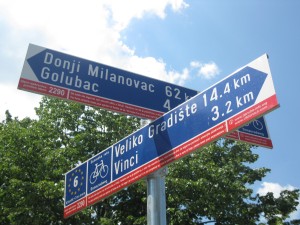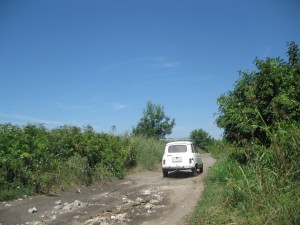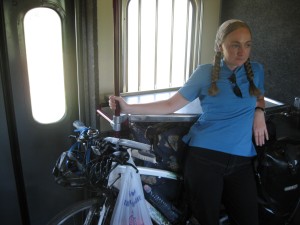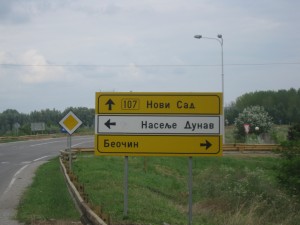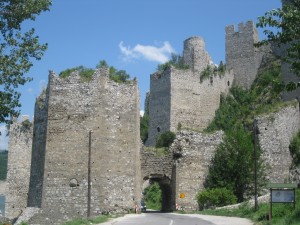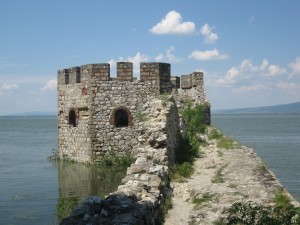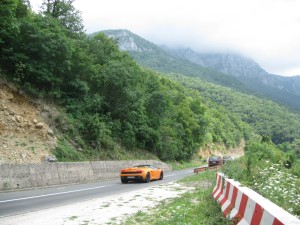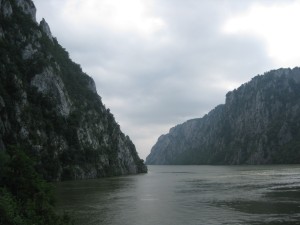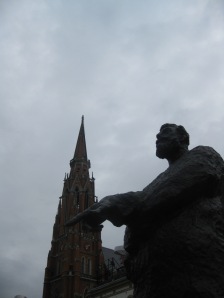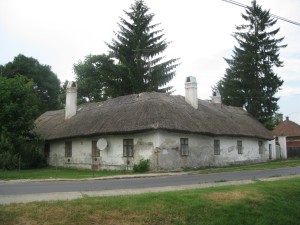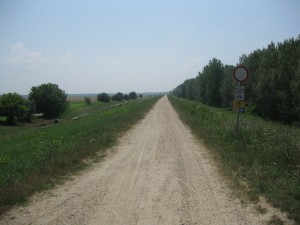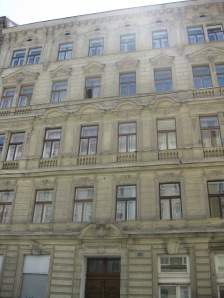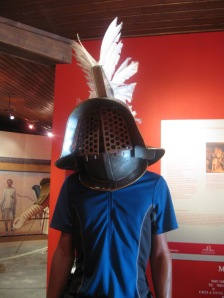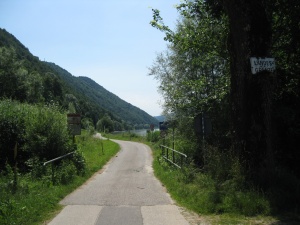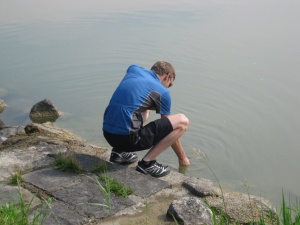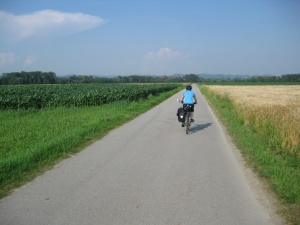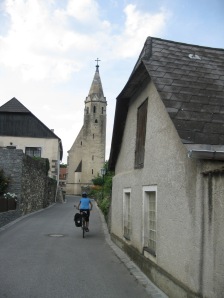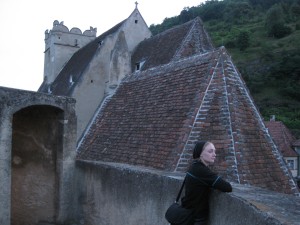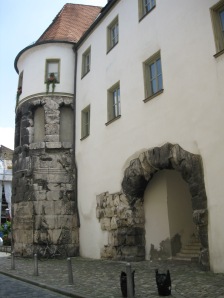In Serbia, we felt like we had to work hard for every kilometer. The roads are a lot rougher, and we encountered some substantial hills that were not marked on our bike map. A hill is always harder when you’re not expecting it. We also had a day of steady headwinds and crosswinds, which meant we were only able to go about half our normal speed, and we got worn out very quickly. Somewhere along the way, we noticed that the signs marking the bike route had amusing little phrases at the bottom. We found one that said, “You have certainly made your opinion of Serbia so far. We hope it is a nice one, but if it is not completely so, here is something that is sure to help: please lower your expectations. 🙂 ”
The day that we biked to Belgrade was the kind of day when you wonder if everything is actually happening or if you are just dreaming it. To get to the city, we had the choice of going on a busy road with traffic and hills, or an unpaved path through the fields. The guidebook had a nice picture of the unpaved path, showing it as a straight, level, hard-packed dirt path. You can probably guess where this is going; if you guessed that the path looked nothing like the picture, you’re right. It was bumpy and muddy and rocky and had deep holes that had been filled with pieces of broken pottery—definitely not the best surface for bike tires, but fortunately we made it without any flats. We took our own picture of the path and thought maybe we should send it to the company that made the guidebook so they can update their picture. Every once in a while, an old Renault or Yugo would come bumping along the “road” and we had to pull off to let them pass. We were wondering where these people were going, and they were probably wondering the same about us.
Finally we got back on a real road and made it into Belgrade; we were glad that part of the route took us through a park so we could avoid some of the traffic. Our plan was to take a train out of Belgrade to bypass what the guidebook described as “the stress, traffic and climbs of the not particularly attractive main route to Smederevo.” The guidebook made the process of taking a train out of Belgrade sound pretty simple. Maybe we should stop believing what the guidebook says.
When we went to buy our tickets, we were told by a no-nonsense employee that bikes were not allowed on the train. We decided that there must be some way around this, and we resorted to asking broader and broader questions until we got an answer we liked. Is there a different train that takes bikes? Is there a train to Romania that takes bikes? Is there any train that takes bikes? Finally the employee told us that maybe we could ask the conductor, and he might let us take our bikes on the train. That answer was good enough for us. On our way out to the train platforms, we saw an information office and decided to try asking there. This time we got a young girl who spoke a lot more English and was much more optimistic about whether we could take our bikes on the train. Sure, no problem, just ask the guy who sells tickets at the front of the train. We learned that it pays to ask several people several times.
We found our platform and waited for our train to arrive. A couple minutes before the train was supposed to depart, it still hadn’t arrived, but we noticed a steady flow of people boarding a train on the next platform. Lindsay checked the train schedule and found out that there wasn’t supposed to be a train on the next platform, so we started to wonder if that was our train. We ran over with our bikes and asked the conductor, and indeed it was our train. When we asked about taking our bikes on the train, we got a similar series of answers: no…well, maybe…OK, put your bike on the train now so we can leave. There was no designated space for bikes like on German and Austrian trains, so we stood with our bikes in the entryway for the next couple hours. There was no ventilation in that part of the train and no seats, and every time we tried to sit down on the floor, someone would walk through and we would have to get up. We weren’t sure if this was really any better than just biking through what we were skipping by taking the train.
Fortunately, Serbia made up for its difficulties with some beautiful views and very friendly, hospitable people. We have found the Serbian taxi drivers to be especially helpful. Several times when we were standing along the road looking at our map, a taxi driver has pulled up to give us directions. One even drew us a little map of the turns we had to take to get through town, since our bike map is not very detailed. Further complicating our navigation is the fact that half of the signs are written using the Cyrillic alphabet. By the end of our time in Serbia, we got pretty good at deciphering Cyrillic.
Our last couple days of biking in Serbia were some of the most memorable days of the trip. One day we started out at Silver Lake, which was beautiful and peaceful. Our route took us right along the Danube the whole day – that’s actually pretty unusual, because in some parts of the route we don’t see the Danube for many kilometers. The road went right through Golubac castle (yes, literally through), which was built in the 13th century; some of the towers rise out of the Danube River. The rest of our route went past rocky cliffs which provided amazing views. Also, we went through close to 20 tunnels that day—we walked our bikes on the sidewalk through all but the shortest ones, as the tunnels had no artificial lighting. We were very glad for the lights on our bikes then.

Tunnel #4, the longest tunnel we went through, measuring over a third of a kilometer...it looks dark in there...
That day we only went through a few small, isolated towns which offered no accommodations and hardly any grocery stores. We had to plan the day well so we had enough to eat and drink along the way. We ended the day in Donji Milanovac, which had somehow thrived more than the other towns and offered several hotels and restaurants. There we ran into two other travelling couples—one German couple that was also biking the Danube, and one German/Italian couple that was backpacking around Europe. It’s always refreshing to meet other travelers who understand your experiences.
That evening, the town happened to be having their annual fish soup festival, where many people from the town gather to cook their fish soup in big kettles over a fire. We joined the small crowd sitting on the bleachers to watch the action, but we couldn’t quite gather from observation how it was supposed to work, so we asked some young guys sitting nearby if they spoke English and could explain it to us. One of them explained that this is a traditional festival for all the towns in Serbia that are along a river. Judges and spectators can try each of the soups, and at the end of the evening one is chosen to win a prize for the best fish soup. Each chef has his own secret recipe with different kinds of spices and fish from the Danube. Together with our new friends, we tried a few different recipes and took our guess at which one would win.
The next day was our last day in Serbia. After going through a few more tunnels, we reached the Danube’s narrowest point, where it breaks through the mountains. We made slow progress as we stopped every few minutes to take pictures of the beautiful views. At one point we were snapping pictures of the river when Lindsay told David to quickly turn around and look at what was coming. He turned and managed to snap a couple pictures of a Lamborghini zipping by with a dramatic mountain landscape in the background. Finally the road descended to the border crossing where we would leave Serbia and enter Romania.
_________________________________________________
*Answer to “Can you read this?”: The first city listed on the sign is Novi Sad, one of the cities we passed through on our route. We don’t know what the other words say. 🙂
